The "mystery" of Vogue magazine
Some official information about the latest magazine Vogue, or rather, about its interactive module.

To be honest, I wanted to gladden the IT people at the beginning of the next working week with good news, since it was frankly not up to the info lines, but ...
')
There is such a company Americhip - as you can guess from the name, it is American. The existence of the company began in 1987 and since then the company has managed to become the leading developer of advertising solutions in the field of Multisensorize - product sensation technologies in print media. Now Americhip is dozens of branches and exclusive distributors, a huge portfolio and many well-known companies around the world among customers ... well, you understand.
Most recently, the company introduced its new development called Video-in-Print (video in print) - this technology was developed since 2007 and the main difficulty was resolving contradictions: a new advertising medium had to be thin (to be embedded in print media), durable ( to reproduce the recorded materials several times), replicated (to provide any number of placements the advertiser needs). As you can see, the tasks were solved - for the first time the development was presented in America in September 2009 - in the magazine Entertainment Weekly, in which 4 commercials of the CBS and Pepsi TV channel were posted. The video could be viewed by opening the corresponding page.
In Russia, this technology appeared a bit later - on September 19, 2010, First Deputy Prime Minister Igor Shuvalov and President of the Skolkovo Business School Ruben Vardanyan presented 21 graduates with unusual diplomas, which, in addition to general information, contained a video about the last year of students in Skolkovo . The second and more accessible example of use was a pilot project (circulation of 7,000 copies) of Vogue magazine, in which Martini posted its Martini Gold ad with irresistible Monica Belucci and ... Domenico Dolce and Stefano Gabbana starring (the magazine should be found on the sticker “Only in Vogue video with Monica Bellucci ").
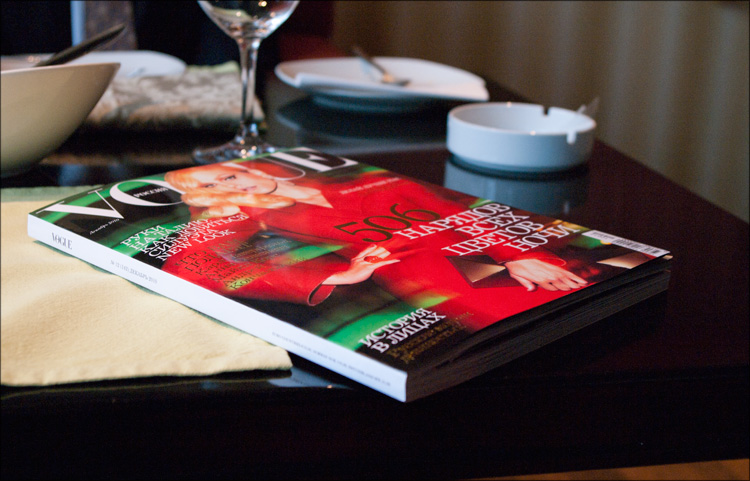
At the moment, the technology components are:
- Thin liquid crystal display with a resolution of 320x240. Screen size can be 6, 10 or 13cm. Color.

- Autonomous power supply - the battery lasts for 45-60 minutes of video viewing. Activation - when opening the page
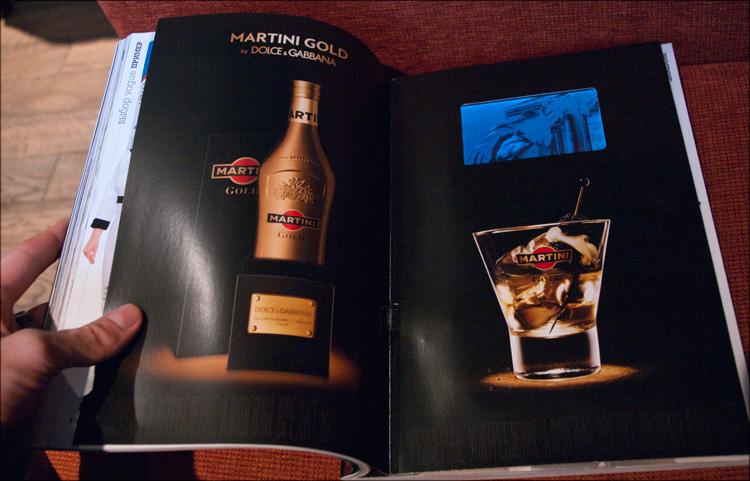
- Commercials are recorded on a flat chip capable of storing up to 5 video files, with a duration of up to 45 minutes of video (the memory capacity is about 800 MB).
- The device is equipped with a miniUSB connector for charging
- There is a built-in speaker for audio playback
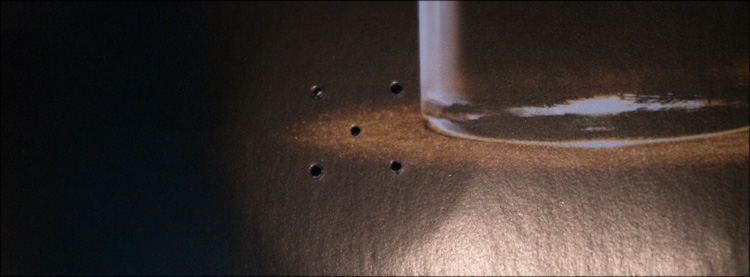
- The thickness of the "page" is about 2 mm

From the above, we can conclude that the "reklamka" is not at all disposable. Moreover, it is unique in its essence (besides its sudden appearance) - all its uniqueness lies in its multifunctionality. This may bebare rods traditional advertising media, and educational materials, and commercial product catalogs. Of course, all this is strongly patented "from and to" - from the assembly method and installation, ending with the principle of discovery. Sorry for not posting more details on the electronics itself - I forgot the magazine in the office :)
Interiors (photo taken from LJ by Mikhail Pchelnikov)
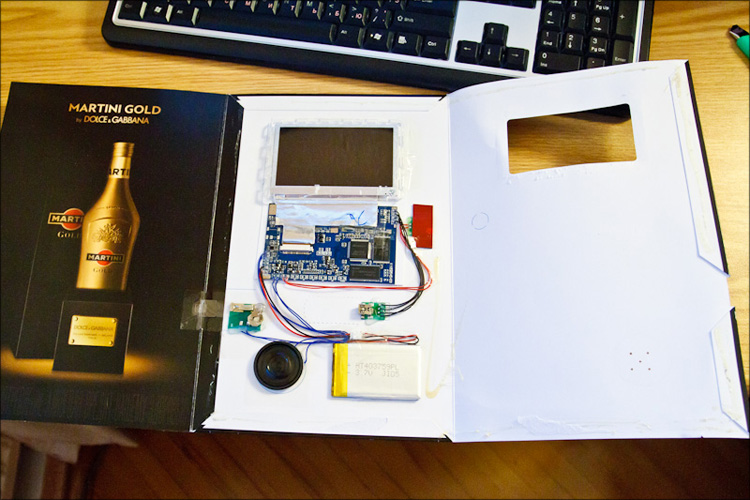
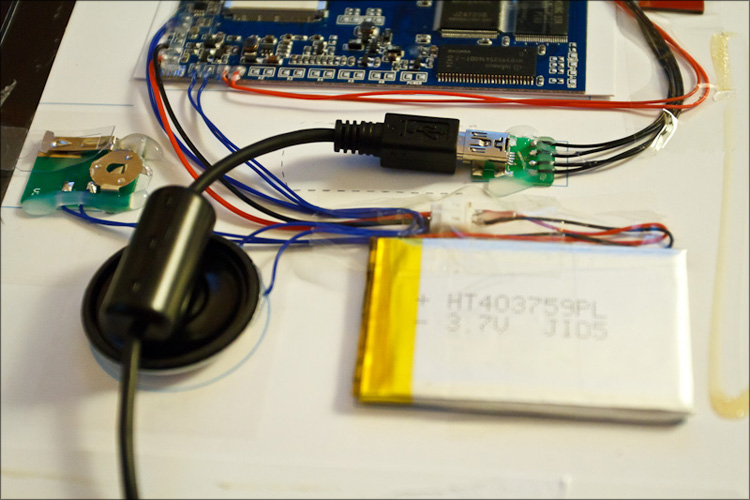
As you understand, such models are technically complex, and therefore expensive. More precisely, for “readers-diggers, the price of magazines with such a bun should not change, but for advertisers each module will cost from 30 to 500 euros (depending on its complexity). So I propose to rejoice again - most likely we have to otkovyrivat advertising only the most affluent companies. So far, all this is “printed” in the states, and it takes about 4-6 weeks from the moment of ordering to printing and delivery to our cold lands. Perhaps soon “printing” factories will appear in Russia, at least money has already been invested in it; as a result, advertising modules should be cheaper.
In addition to Video-in-Print, Americhip has developed other successful solutions throughout its existence, including:
- Audio-in-Print
- Amerimotion
- Light-in-Print
- Touch-in-Print
- Taste-in-Print
What a great thing! Why? Because with a very high probability they will be buying up the entire print run, so various crafts from LCD screens will soon join the “wooden flash drives” DIY blog) But if without a joke, such an artifact is really unusual, attracts attention and surprises - by the most modest estimates such a magazine (or rather, the advertisement itself) will be reviewed by at least 10-15 people, while among the most successful “regular” magazines this figure is five times lower - 2-3 people. More serious research on the effectiveness of such advertising has not been conducted - it is still to come.
What will happen next? I am afraid the audience of Habrahabr will not believe me;) Sensory technologies have already been developed that are waiting to be born. Moreover, there is a prototype of a video with a burning candle that goes out if you blow it. Also, the diagonal of the screens will grow - as long as everything depends on the weight of the inserts themselves, since inserting a heavy “foreign body” into a large circulation comes out very expensive.
Let's all laugh together if Habrahabr turns out to be the main audience of Vogue magazine readers) But I am sure that the circulation has not yet sold out - search, buy, pick, study, fill. Do not worry that someone is not enough - everything is just beginning. The main thing is that it does not roll afterwards just like that, but find real use. And I am sure that on Habrahabr it will find it; if you fail to use all the electronics entirely, you can always use the display.
Video from the post " Breaking Vogue magazine or video player for 119 rubles ."
I wish this technology prosperity;) All the rest - a pleasant weekend.

To be honest, I wanted to gladden the IT people at the beginning of the next working week with good news, since it was frankly not up to the info lines, but ...
')
There is such a company Americhip - as you can guess from the name, it is American. The existence of the company began in 1987 and since then the company has managed to become the leading developer of advertising solutions in the field of Multisensorize - product sensation technologies in print media. Now Americhip is dozens of branches and exclusive distributors, a huge portfolio and many well-known companies around the world among customers ... well, you understand.
Most recently, the company introduced its new development called Video-in-Print (video in print) - this technology was developed since 2007 and the main difficulty was resolving contradictions: a new advertising medium had to be thin (to be embedded in print media), durable ( to reproduce the recorded materials several times), replicated (to provide any number of placements the advertiser needs). As you can see, the tasks were solved - for the first time the development was presented in America in September 2009 - in the magazine Entertainment Weekly, in which 4 commercials of the CBS and Pepsi TV channel were posted. The video could be viewed by opening the corresponding page.
In Russia, this technology appeared a bit later - on September 19, 2010, First Deputy Prime Minister Igor Shuvalov and President of the Skolkovo Business School Ruben Vardanyan presented 21 graduates with unusual diplomas, which, in addition to general information, contained a video about the last year of students in Skolkovo . The second and more accessible example of use was a pilot project (circulation of 7,000 copies) of Vogue magazine, in which Martini posted its Martini Gold ad with irresistible Monica Belucci and ... Domenico Dolce and Stefano Gabbana starring (the magazine should be found on the sticker “Only in Vogue video with Monica Bellucci ").

At the moment, the technology components are:
- Thin liquid crystal display with a resolution of 320x240. Screen size can be 6, 10 or 13cm. Color.

- Autonomous power supply - the battery lasts for 45-60 minutes of video viewing. Activation - when opening the page

- Commercials are recorded on a flat chip capable of storing up to 5 video files, with a duration of up to 45 minutes of video (the memory capacity is about 800 MB).
- The device is equipped with a miniUSB connector for charging
- There is a built-in speaker for audio playback

- The thickness of the "page" is about 2 mm

From the above, we can conclude that the "reklamka" is not at all disposable. Moreover, it is unique in its essence (besides its sudden appearance) - all its uniqueness lies in its multifunctionality. This may be
Interiors (photo taken from LJ by Mikhail Pchelnikov)


As you understand, such models are technically complex, and therefore expensive. More precisely, for “readers-diggers, the price of magazines with such a bun should not change, but for advertisers each module will cost from 30 to 500 euros (depending on its complexity). So I propose to rejoice again - most likely we have to otkovyrivat advertising only the most affluent companies. So far, all this is “printed” in the states, and it takes about 4-6 weeks from the moment of ordering to printing and delivery to our cold lands. Perhaps soon “printing” factories will appear in Russia, at least money has already been invested in it; as a result, advertising modules should be cheaper.
In addition to Video-in-Print, Americhip has developed other successful solutions throughout its existence, including:
- Audio-in-Print
- Amerimotion
- Light-in-Print
- Touch-in-Print
- Taste-in-Print
What a great thing! Why? Because with a very high probability they will be buying up the entire print run, so various crafts from LCD screens will soon join the “wooden flash drives” DIY blog) But if without a joke, such an artifact is really unusual, attracts attention and surprises - by the most modest estimates such a magazine (or rather, the advertisement itself) will be reviewed by at least 10-15 people, while among the most successful “regular” magazines this figure is five times lower - 2-3 people. More serious research on the effectiveness of such advertising has not been conducted - it is still to come.
What will happen next? I am afraid the audience of Habrahabr will not believe me;) Sensory technologies have already been developed that are waiting to be born. Moreover, there is a prototype of a video with a burning candle that goes out if you blow it. Also, the diagonal of the screens will grow - as long as everything depends on the weight of the inserts themselves, since inserting a heavy “foreign body” into a large circulation comes out very expensive.
Let's all laugh together if Habrahabr turns out to be the main audience of Vogue magazine readers) But I am sure that the circulation has not yet sold out - search, buy, pick, study, fill. Do not worry that someone is not enough - everything is just beginning. The main thing is that it does not roll afterwards just like that, but find real use. And I am sure that on Habrahabr it will find it; if you fail to use all the electronics entirely, you can always use the display.
Video from the post " Breaking Vogue magazine or video player for 119 rubles ."
I wish this technology prosperity;) All the rest - a pleasant weekend.
Source: https://habr.com/ru/post/108921/
All Articles